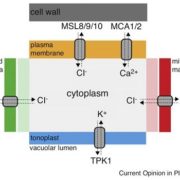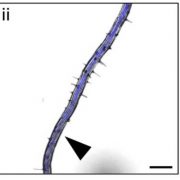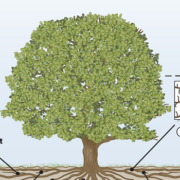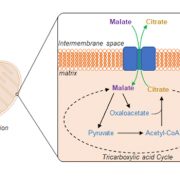Boron Transport in Rice
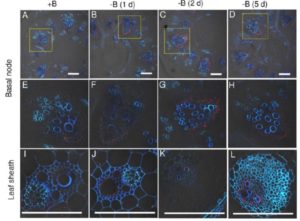 Boron (B) is an essential micronutrient for plant growth and development. Its major physiological function is to maintain the structure of the cell wall by crosslinking pectic polysaccharides through borate-diol bonding of two rhamnogalacturonan II molecules. B is immobile in most plant species. Therefore, a continuous supply of B is required to maintain growth of newly developing tissues and deficiency of B will result in the cessation of root elongation, reduced leaf expansion, and loss of fertility. On the other hand, B also shows toxicity to plants when present in excess. Both B deficiency and toxicity cause crop losses in many areas of the world.
B is preferentially delivered to developing tissues in many plant species under conditions of low or no transpiration but the molecular mechanisms underlying the preferential distribution of B to these developing tissues are poorly understood. Here, Shao et al. (10.1104/pp.17.01054) present evidence that a member of nodulin 26-like intrinsic protein (NIP), OsNIP3;1, is involved in this preferential distribution in rice. OsNIP3;1 was highly expressed in the nodes and its expression was up-regulated by B deficiency, but down-regulated by high B. OsNIP3;1 was localized at
the xylem parenchyma cells of enlarged vascular bundles of nodes facing toward the xylem vessels. Furthermore, this protein was rapidly degraded
within a few hours in response to high B. Knockout of this gene scarcely affected the uptake and root-to-shoot translocation of B, but altered B distribution in different organs in the shoot.
These results indicate that OsNIP3;1 located in the nodes is involved in the preferential distribution of B to the developing tissues by unloading B from the xylem in rice and that it is regulated at both the transcriptional and protein level in response to external B level.
Boron (B) is an essential micronutrient for plant growth and development. Its major physiological function is to maintain the structure of the cell wall by crosslinking pectic polysaccharides through borate-diol bonding of two rhamnogalacturonan II molecules. B is immobile in most plant species. Therefore, a continuous supply of B is required to maintain growth of newly developing tissues and deficiency of B will result in the cessation of root elongation, reduced leaf expansion, and loss of fertility. On the other hand, B also shows toxicity to plants when present in excess. Both B deficiency and toxicity cause crop losses in many areas of the world.
B is preferentially delivered to developing tissues in many plant species under conditions of low or no transpiration but the molecular mechanisms underlying the preferential distribution of B to these developing tissues are poorly understood. Here, Shao et al. (10.1104/pp.17.01054) present evidence that a member of nodulin 26-like intrinsic protein (NIP), OsNIP3;1, is involved in this preferential distribution in rice. OsNIP3;1 was highly expressed in the nodes and its expression was up-regulated by B deficiency, but down-regulated by high B. OsNIP3;1 was localized at
the xylem parenchyma cells of enlarged vascular bundles of nodes facing toward the xylem vessels. Furthermore, this protein was rapidly degraded
within a few hours in response to high B. Knockout of this gene scarcely affected the uptake and root-to-shoot translocation of B, but altered B distribution in different organs in the shoot.
These results indicate that OsNIP3;1 located in the nodes is involved in the preferential distribution of B to the developing tissues by unloading B from the xylem in rice and that it is regulated at both the transcriptional and protein level in response to external B level.



